Letters from Lodi
An insightful and objective look at viticulture and winemaking from the Lodi
Appellation and the growers and vintners behind these crafts. Told from the
perspective of multi-award winning wine journalist, Randy Caparoso.
Seven basic ways to improve your wine life

Wine lovers at a past Lodi ZinFest (soon to be revived as Lodi Row X Row)
I'm no Dr. Phil, but after over 40 years of enjoying, writing about, and making a living out of wine, I know a few sensible things that can improve your life immensely. If you happen to be a wine lover. Things are not covered (or else, not fully explained) in most books or online advisories.
Those seven basic ways:
1. Do not hold wine glasses like they do on television or in the movies.
I don't know what it is, but almost 100% of the time that glasses of wine are held by our favorite television or movie stars, they're shown holding their wine glass by the bowl rather than the stem. This is bad, bad, bad, because not only does this look unsophisticated (such a downer when you really like the actor), but it also results in grimy fingerprints all over the glass (especially if you're also touching food — like peanuts, garlic bread, barbecued chicken or ribs — with your hands). Ahem, why do you think wine glasses have stems? Holding glasses by the bowl rather than the stem also affects the temperature of the wine — you never want to heat up a nicely chilled white wine, or even a red, with the body temperature emanating from your paws. Practice holding by the stem.
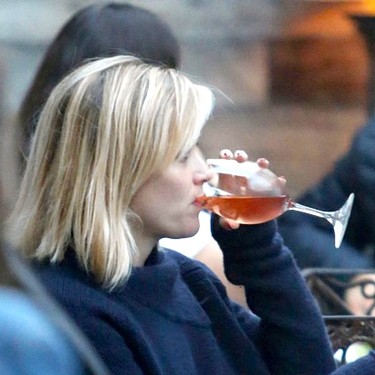
Who doesn't adore Reese Witherspoon? Alas, if only she would hold a glass of rosé the right way.
2. Swirl your wine and smell it before taking a sip.
Assuming you've mastered the art of holding the glass by the stem, the next step is learning how to swirl without feeling self-conscious or pretentious. The important thing is knowing that you must swirl in order to get the wine to touch the sides of the glass, which in turn creates the vapors that you smell, which in turn creates the aromas that the mind and palate perceive as "flavor."
Simply put, when you can't smell, nothing (neither food nor wine) has any taste. And so to accentuate the taste of wine, you swirl. If it feels awkward at first, I suggest moving your glass around in a little circle as it sits on the table. It's no big deal, but practice doesn't hurt if you want to look good doing it next time in public.
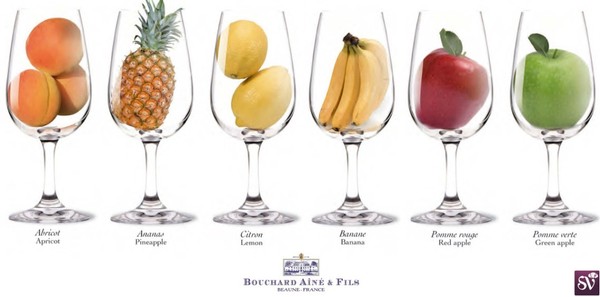
Examples of aromas and flavors commonly perceived in wines in a chart by Bouchard Aîné & Fils
3. Sniff, don't snort, your wine.
Have you ever observed cats analyzing food dishes? They don't shove their nose into it, they just take a few discreet sniffs a little ways from the dish, usually moving their noses around a little bit. I like to think we're even smarter than cats. Therefore, when smelling your wine, the strategic thing is not so much breathing in as much as possible with the nose as opening your mind up to what the wine reminds you of. Professional wine tasters, especially those in Europe, are taught to sniff the wine with one nostril (most people have one that's "better" than the other) just around the rim of the glass.
When you stick your entire nose into the glass, the tendency for most people is to be distracted from the process of analyzing aromas, which is actually a thought process, not a physical process. As Yogi Berra once famously said, "Baseball is 90% mental... the other half is physical." It is the brain that tells you what a wine smells and tastes like, and even how much or little pleasure you're getting from that experience; so you need to practice smelling and sipping in a way that best allows you to extrapolate sensory impressions that are, in fact, based upon prior memories of smells and experiences.
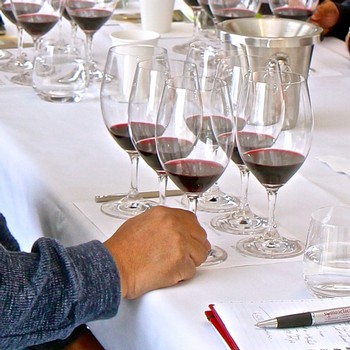
Cabernet Sauvignon tasting
A good Cabernet Sauvignon, for example, reminds most people of dark fruit or berry liqueurs; and when a Cabernet Sauvignon is fermented and aged in oak barrels toasted on the inside by an open fire (which is how barrels are coopered), a Cabernet Sauvignon typically retains additional qualities of vanilla, cream or smokiness in the aroma and flavor. Why is this important to recognize? Because if you've spent $25, $50, or more on a bottle, these are the aromas and flavors you've paid for. You don't lay down $100 for a concert and then sleep through the first hour. Therefore it doesn't make sense to drink any fine wine just for its alcoholic content (liquor, as Ogden Nash would say, would have been quicker). Discreetly sniff at your wine before you drink it, and enjoy the nuanced qualities that make it special.
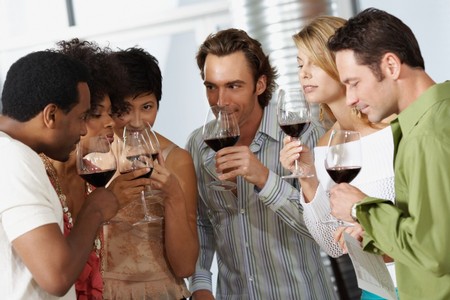
Lodi wine lovers
4. Taste wines with no preconceptions.
One of the most common errors made by inexperienced wine tasters is assuming that what you smell (as important as smelling may be) automatically carries through on the palate. A Zinfandel or Syrah, for instance, can be beautifully rich, lush, and juicy in the nose, yet unpleasantly rough and grainy on the palate. Aromas define flavor, but they do not necessarily determine how fine or smooth, balanced, or harmonious a wine ultimately comes across once it reaches the mouth. Wines should be smooth and well-balanced — who wants to drink something that tastes like a shoe or, worse yet, a shoe kicking you in the mouth?
All you really taste on the palate is the tactile feel of body (the weight of a wine, mostly determined by its alcoholic strength), and then the primary sensations of sweetness (or if the wine is dry, lack of sweetness), sourness (in white wines — not so much in reds — determined by level of acidity in wine), and bitterness (in red wines — not so much in whites — contributed mostly by tannins derived from skins and seeds of grapes, since red wines are fermented with skins and seeds). These sensations give physical definition to aromas and flavors; and in the finest wines, these sensations are imparted with positively fresh, lively, compelling qualities. In fact, a wine with just a so-so nose that tastes smooth and balanced tends to be more enjoyable than a wine that smells great but is dull, harsh, or off-putting in the mouth.
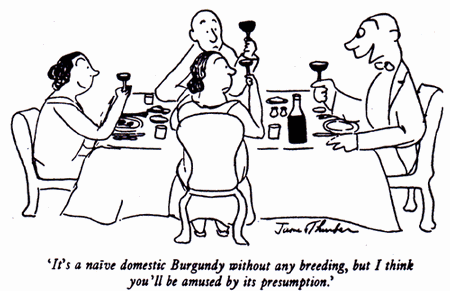
Classic James Thurber, published in New Yorker in 1937
5. Do not use the "geekspeak."
Unless your family and friends are the forgiving types, pretentious wine chatter like that of the proverbial wine snob in James Thurber's classic New Yorker cartoon is never an endearing form of behavior.
What are some of the more painful words used by so-called wine experts? Well, I like complexity in wine, but the word "complex" sounds elitist. If you find a wine to be smooth and rich, to be wonderfully full or amazingly light, or have multiple flavors of fruit, flowers, earth, and wood, then, by all means, go ahead and extol those qualities out loud. Just lay off the C-word.
"Acidity," like complexity, is very desirable in wine, but not desirable in conversation. If a wine has good acidity, talk about its crispness, its freshness, or its zesty, tart, sharp, or even steely-edged qualities ("sour" is not so flattering, unless the wine actually is as unpleasant as that). But "acidity" sounds sterile, "high acid" even more solemn, and this is wine, not the church.
Wine experts often talk about "finish" — the tactile impressions left in the mouth after a wine is swallowed. Now who likes people who talk about the taste of wine after it's already swallowed? Sip your wine, take another bite of food, and maybe throw in a little sigh; but then be done with it. No talking of "finish" at the dinner table!
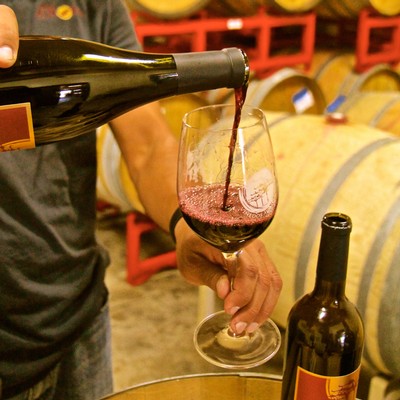
Dark, fuller-bodied (i.e., higher in alcohol) reds such as Petite Sirah can look "leggy" in the glass
"Legs" is another popular word, referring to the visible rivulets of wine as it slides down a glass. Generally speaking, the higher the alcohol in wine (creating greater surface tension inside of the glass) and the deeper the intensity of color (especially for reds), the more visible the legs. Higher alcohol and deeper colors in wine, however, are not signs of a better wine. The best white wines made from Albariño or Sauvignon Blanc grapes, for instance, are usually moderate in alcohol level (!2% to 13%). They may not look "leggy," but they're better off that way. Red wines made from the Sangiovese and Pinot noir grapes tend to be lighter in color and thus less leggy than other red wines (such as Cabernet Sauvignon, Merlot, and Petite Sirah), but are also certainly among the finest in the world. In fact, emphatically leggy, overly alcoholic table wines often leave a horrid, "hot" taste on the palate. My advice: Go ahead and make note of the "legs" wherever you might find them, but leave them out of polite conversation.
"Breathing." We are often asked, especially in expensive restaurants, "Shall we open your bottle ahead of time to let it breathe?" Well, there are few things as silly as the notion that exposure of less than a square inch of wine at the neck of the bottle to the oxygen will result in increased quality of the wine therein. Not a chance.
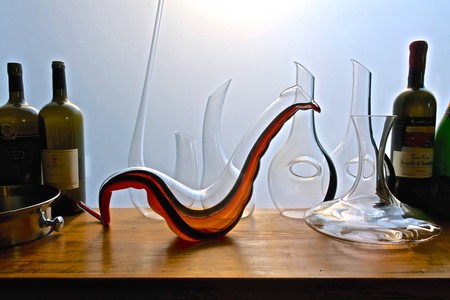
Graceful wine decanters in Denver restaurant
Many of the best restaurants these days are staffed by wine specialists, called sommeliers. Sommeliers love to "decant" your wine — pouring it from the bottle and into a beautifully shaped glass container — under the assumption that even more dramatic exposure to air will increase overall quality. There have been, in fact, studies that have shown that decanting does not actually "improve" the taste of wine (see our 2012 post, Does price and letting wines breathe matter?), despite the general assumption that it does. Most wines, in fact, taste freshest and most intense when simply opened and immediately poured into your glass.
This is not to say that if you have a beautiful wine decanter you shouldn't use it, especially when serving wine to guests in your home. Quality of wine is such a state of mind, anything you do to make the perception of a wine experience a more positive one can only be good, and wine poured out of a gracefully shaped decanter is a good thing. As long as you understand the mythical nature of "breathing," which makes the word itself illogical and thus to be avoided.
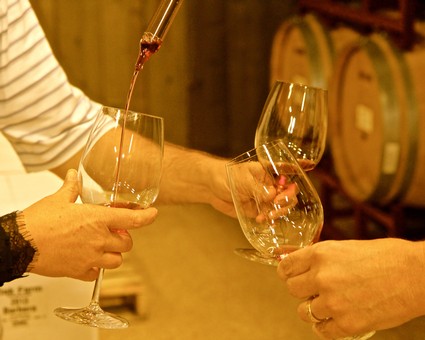
Barrel tasting at a Lodi winery
6. Don't scrimp on glasses!
Here's the ultimate alternative to "breathing": Drink wines in good, spacious wine glasses.
Everyone knows that wine glasses properly come with a stem, are crystal clear for visual pleasure, and are curved inward to allow the nose to better enjoy the aromas collecting just below the rim. But size and shape also matter. Generally speaking, white wines taste best in 12 to 14-ounce glasses in the graceful shape of a tulip. But for red wines, you can use the same 12-ounce tulip as you do for whites, but they won't taste nearly as good as in a bigger, 16, 18, even 22, or 28-ounce glass.
Why? Red wines, being denser and heavier than white wines, need a larger surface area to create the vapors (through swirling) that increase aromatic qualities. And the more aromas you smell, the more flavors you taste on the palate. If you doubt it, do a side-by-side comparison — tasting a red in a small glass next to the same in a large glass — at home or in the next fine restaurant you go to. I guarantee you'll taste the difference.
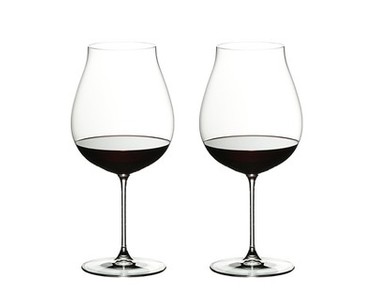
Bowl-shaped Burgundy style glasses designed by Riedel and sold at Target
Although elongated tulip shapes at least 16-ounce in size do well for most reds, a lot of red wine lovers go even further, preferring round, bowl-shaped glasses (i.e., the classic "Burgundy" glasses), which tend to have even larger surface areas for vapors to work off of. What the bowl shape also does is allow red wine to enter the palate closer to the tip of the tongue (as opposed to the center). When entering the palate this way, red wines touch a larger surface area of the tongue, which enhances the taste of more delicate red wines such as Pinot noir and French Beaujolais, or floral/earthy reds made from Nebbiolo. Bowl-shaped glasses, in other words, enhance red wines that are rounder and fruitier (they can also be surprisingly good, incidentally, for richer styles of Chardonnay).
By the same token, heavier, sturdier wines with stronger degrees of tannin — such as Cabernet Sauvignon, most Syrahs, and Petite Sirahs — tend to taste better in large tulip-shaped rather than bowl-shaped glasses because tulip shapes are more likely to enhance the broad, structured feel that are prized in fuller-tannin reds.
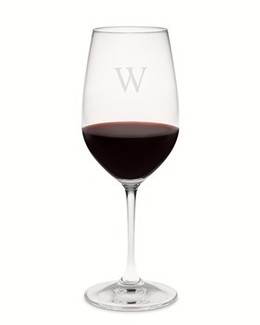
The ideal, 13-3/8-ounce Zinfandel wine glass (also ideal for most white wines and rosés) designed by Riedel, carrying a Williams Sonoma® seal
The best wine glass for Zinfandel? Believe it or not, those tend to be moderate-sized (12 to 14 ounces) tulip-shaped glasses — the same kind of glasses that are ideal for most white wines and rosés. Why? Because the most attractive part of most Zinfandels is their berryish aromas (often described as "jammy"), which are more concentrated when smelled from smaller, narrower glasses. Bigger, more bowl-shaped glasses tend to dissipate Zinfandel aromas. It's like anything in life: When you've got it, you flaunt it, and you always want to flaunt the wild berryish fruit qualities of a good Zinfandel in a narrow, tulip-shaped wine glass.
Riedel Crystal was a pioneer of many of these variations of oversized glasses, but you don't have to spend over $15 per glass on crystal specialists such as Riedel, Spiegelau, Ravenscroft, or Schott Zwiesel. There are plenty of other good-sized, economically priced alternatives available online, in many kitchen supply stores, and even at your closes Target.
Bottom line: Life's too short for lousy wine glasses!
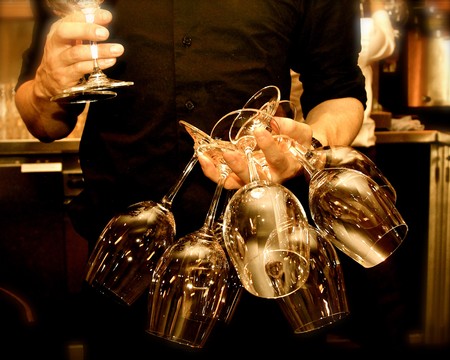
Classic tulip-shaped wine glasses
7. Serve at proper temperatures.
Aside from inadequate glassware, the second most common way that wine drinkers abuse themselves is by serving wines at the wrong temperature.
White, pink, and sparkling wines are best served chilled (38° to 40° Fahrenheit). Simple enough — a couple of hours in the fridge will do it (or half an hour in the freezer if you're in a hurry). Cooler temperatures tend to accentuate the aromas and flavors of fruit and the sensation of freshness, which is what these types of wines are all about.
Red wines are a little trickier. Most red wines are not at their best served well chilled like white wines because of their higher tannin and weight lock-in aroma and flavor at lower temperatures. So books and back labels recommend "room temperature" for reds. But keep in mind that the ideal room temperature for wines is not the same as for human beings; ideally, it is somewhere between 60° and 68° — significantly cooler than a typical summer day, or even where many of us set our thermostats during the winter.
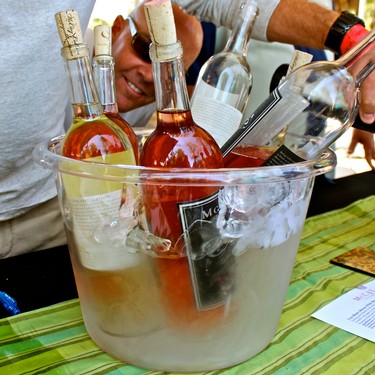
Chilled joy at a past Lodi ZinFest
Softer, fruit-driven red wines, such as many Pinot noirs, are probably best enjoyed even closer to 60°. If starting from 70° to 80° room temperatures, 45 to 60 minutes in the refrigerator will get your softer, lighter red wines to the perfect serving temperature, giving them the perception of being fresher, juicier, or richer.
Heavier red wines such as Cabernet Sauvignon, Merlot, Syrah, Petite Sirah, and pricier Zinfandels are usually best around 65° (or about 30 minutes in the fridge). If anything, it's important to remember that heavy red wines are not enjoyable at all if served too warm (at 80° or higher). "Hot" temperatures tend to accentuate a big red's alcohol and tannin, making the wine taste coarse or rough, and detracting from the natural fruit qualities and complexities winemakers try so hard to produce.
Most of us, as it were, do not have fancy wine cellars, where wine is stored at ideal, long-term temperatures (55° to 60°). The vast majority of wines in the U.S. are consumed within four hours from purchase, usually in a local supermarket or discount liquor store. Nothing wrong with that. As long as you understand the basic things that make wines taste better, like the right glasses and the most sensible serving temperatures. Why settle for anything less?
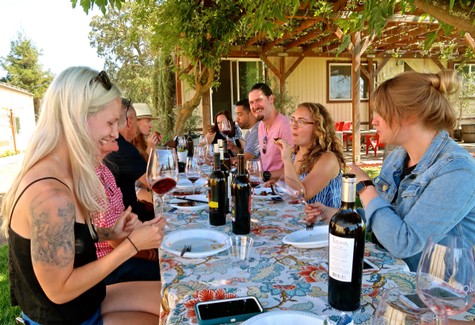
Visiting sommeliers enjoying lunch at Bokisch's Terra Alta Vineyard in Lodi's Clements Hills AVA